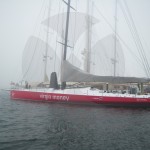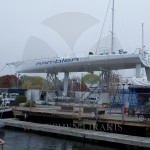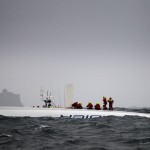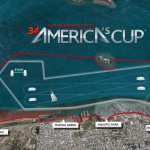The america’s cup race course for San Francisco Bay is published.
The following update is from Sailing Anarchy.
the ‘blur story
Our friend Aaron Kuriloff from Bloomberg News sends in his story on the Rambler Fastnet capsize from the Bloomberg Pursuits magazine.
The 100-foot carbon-fiber yacht was doing what it was designed to do, surging down the waves, at moments actually sailing faster than the wind. The boat, Rambler 100, and skipper George David, the former chief executive officer of United Technologies Corp., were leading the fleet in
the U.K.’s famous Fastnet ocean race. It was Aug. 15, 2011, and the giant sloop was beginning to act like the champion that hedge-fund manager Alex Jackson had in mind when he had it built, Bloomberg Pursuits magazine reports in its premier issue.
In July, Rambler 100 had been first to finish the Transatlantic Race from Newport, Rhode Island, to the Lizard, Great Britain’s southernmost point. In one 24-hour period during that passage, she logged 582 nautical miles, just 14 shy of the record for a monohull (catamarans and trimarans go faster). That’s an average speed of 24.25 nautical miles per hour, or knots, equal to about 28 miles per hour.
At 5:17 p.m. local time, Rambler 100 rounded Fastnet Rock in the Atlantic Ocean, 8 miles (13 kilometers) off the Irish coast, reaching the race’s halfway point on pace to claim a course record. At 5:40 p.m., everything went wrong.
The 29,000-pound (13,000-kilogram) stainless-steel-and-lead keel broke off without warning. The boat spun and stopped and within 15 seconds was on its side, sails flat on the water. Some
among the 21-person crew were thrown clear of the boat; others scrambled out of the cabin as the yacht’s roll continued. In 60 seconds, Rambler 100 was upside down, its mast pointing to the
seafloor.
Adrift
Crew members who made it onto the overturned hull helped pull others from the water, while five people, including 69- year-old David, were swept by wind and current away from the boat. Winds were gusting to 30 knots, visibility was poor and the water was 57 degrees Fahrenheit (14 degrees Celsius). A person without protective gear might expect to lose consciousness in an hour or two and die from hypothermia in six. George David’s love of the water goes back to when he was a teenager sailing small boats. He moved up to 40-footers in the 1970s when he was manager of Otis Elevator’s Latin American operations, stationed in Florida. As he climbed the corporate ranks and grew wealthier (he was worth at least $250 million by the time he retired in 2009, according to data compiled by Bloomberg), his sailing grew more ambitious. In 1999, his state- of-the-art, 50-foot sloop Idler represented the U.S. in the Admiral’s Cup, a prestigious international regatta. In 2006, David acquired a 90-foot (27.5-meter) yacht secondhand, named it
Rambler and went on to set records in several ocean races.
Takeover
Then David worked out an arrangement to take over Jackson’s vessel. The retired executive would run the racing campaign in 2011, serve as skipper, rename the boat Rambler 100 — and pay the bills. The costs at this level of competition, for crew, insurance, repairs, upgrades, travel and so on, can reach $6 million a year. For his money, David had his hands on a boat with an
ultralight hull, giant sails and a radical ballast system that involved water tanks and a keel that pivots — and the potential to finish first in almost any race.
Alex Jackson, 46, co-founder of Polygon Investment Partners LLP, a London hedge-fund firm that today has about $7 billion in assets, had less experience than David with the biggest boats.
He earned All-American honors sailing dinghies for Tufts University’s team and then grew to favor windsurfing. For much of the period from 1986 to 2008, the simple surfboard-with-a- sail was the fastest wind-powered watercraft, pushing the record for average speed on a straight 500-meter course to almost 50 knots. (Today, the title is held by a kiteboard.)
Volvo Boats
Jackson coveted windsurfing’s raw speed. Still, advances in large offshore yachts in the mid-2000s eventually got his attention. He took note, in particular, of the boats Juan Kouyoumdjian, a designer based in Valencia, Spain, was creating for the round-the-world Volvo Ocean Race. These powerful and innovative yachts were pushing the speed record for 24 hours of ocean sailing ever higher. “It was obvious that sailing had taken this huge jump,” Jackson says. “Juan K. had turned sailboats into windsurfers.” Jackson hired Kouyoumdjian with the brief of creating the fastest monohull in the world. He picked a name for his yacht: Speedboat.
Kouyoumdjian’s Design
The project pushed the boundaries of what had been done before, Kouyoumdjian says. He incorporated all of the innovations that made his 70-foot Volvo racers fast — the most radical of these being the canting keel. From the days of rocks piled in the bottom of wooden hulls, keel design has constantly evolved. A typical shape for a modern racing sailboat is a deep fin, like an airplane wing, with a bulb of lead at the bottom that carries most of the weight. The deeper this ballast, the more power it has to counter the force of the wind heeling the boat. Now imagine a system that swings the keel fin as much as 45 degrees to one side of the boat or the other. The leverage jumps dramatically. That’s a canting keel.
For Jackson, Kouyoumdjian wanted minimum weight and maximum sail area to make the boat fast, balanced against the need to build the yacht strong enough for the pounding of waves and
wind. “On the one side, you’re looking for performance; on the other side, safety,” Kouyoumdjian says. The hull was constructed by Cookson Boats in Auckland, which built New Zealand’s 2007 America’s Cup entrant. In April 2008, just three days after it was launched, Speedboat hit 28
knots in Auckland harbor — in just 18 knots of wind.
Laws of Physics
That doesn’t violate the laws of physics. A boat can’t exceed the wind speed when running dead downwind. With the wind from the side, however, many boats top the true wind speed. The
velocity of the wind and velocity of the boat combine to create an “apparent wind” across the sails that exceeds either component. Some catamarans sail twice as fast as the wind. In Kouyoumdjian’s design, adding 30 feet of length to a Volvo racer meant the sail area almost doubled. The carbon-fiber mast was 145 feet.
“Juan K. took the smaller boats’ tech and applied it to the Maxi realm, and in doing so created a boat that was much more powerful than a typical 100-footer,” says Peter Isler, a navigator on two winning America’s Cup boats. “It was pushing the limits.” Isler has been part of the boat’s brain trust since it was launched and was aboard when it capsized. Jackson gave up his hedge-fund duties in June 2008, when his boat arrived in Newport, and turned to racing. That month, in the Newport Bermuda Race, Speedboat was first to finish, ahead of about 200 competitors.
Transatlantic Attempts
At the end of that month, Jackson and his team set out to try for a transatlantic record. They quit after a day, having broken a key piece of equipment. Jackson tried again in October,
this time with Richard Branson among the crew and his Virgin Money as a sponsor. That attempt ended two days out of New York after a gale damaged sails.
Sailing fans were beginning to speculate on blogs that the boat was unseaworthy. “There were a lot of people talking smack,” Jackson says. “The people whose opinion I respect knew what was good, what was bad and what needed to be done.” Still, Jackson returned to managing money, and Speedboat spent most of 2009 at the dock. “I saw the boat basically sitting there, with Alex working 27 hours a day,” says David. They reached an agreement for David to sail the boat as a part owner in 2011. Speedboat became Rambler 100. David, in many ways, began to get it up to its potential — until the Fastnet.
Capsize
It sounded like a cannon being fired when the keel failed, David says. Three people scrambled over the lifelines and up onto the bottom of the boat as it rolled — without even getting wet. Most of the crew ended up in the water but near enough that they could make it onto the overturned hull. David and four others were thrown farther from the boat. That group, including David’s girlfriend, Wendy Touton, 46 at the time, realized they were drifting away from the stricken yacht.
“There was absolute calm,” David says. “No panic. No anxiety. No flailing around. You’re fatalistic in that situation.” While they all had on flotation vests and foul weather gear, the main hazard they faced was hypothermia. As the hours ticked by, they got colder. The sun was dropping. The crew on the hull tried and failed to signal several sailboats that raced by. They didn’t have flares or a hand-held radio. Those items and other emergency gear, including life
rafts, turned out to be inaccessible once the boat was upside down.
Rescue
What saved them were two emergency locator beacons they activated. These sent a satellite signal, and a lifeboat based in Baltimore, Ireland, in County Cork, was dispatched. It arrived on the scene at 7:45 p.m., and only then did the search begin for the group drifting out to sea.
Luck was with David and his crew. Around 8:30 p.m., the crew of the Wave Chieftain, a dive boat that had been on the water that day to photograph the racers rounding Fastnet Rock,
spotted a red blob in the ocean swells. The five sailors were found. Touton, suffering more than the others from the cold, was taken by helicopter to a hospital to be treated for hypothermia.
The rest of the crew were reunited in the town of Baltimore, where local residents provided dry clothes, warm food and beer. The hull of Rambler 100 survived. It was towed to a bay on
the Irish coast, righted and pumped dry. The stub of the keel fin that remained after the break is being examined by a team of metallurgists and engineers.
Indestructible
Things break all the time on racing yachts, but the keel is supposed to be indestructible. As David puts it: “It’s not the sort of thing you pay attention to, because it’s designed from
day one to be permanent, solid, secure and good.” As befits the former head of an aerospace company, David is confident the scientists will figure out what went wrong. Until they do, he and Jackson won’t know whether it makes sense to restore Rambler 100 and sail her again.
David holds no grudge against the boat that almost got him killed. In an interview four months after the accident, he says he had “a lot of fun” racing Rambler 100 in 2011. He was back on
the water, racing his 90-footer from Fort Lauderdale, Florida, to Key West in January. The older boat is fast and agile, he says. “But it feels small.” What’s the attraction of big-boat racing? The retired executive doesn’t invoke the beauty or power of the sea or even the thrill of a fast yacht. I’ve often said racing is like a year of business compressed into a short time,” David explains. “There are all the same elements: design and technology, program management,
organization, staffing, teamwork, rules, tactics and luck.” He still covets ocean racing records, even if in the cold Atlantic last August, his luck seemed to be running thin.




